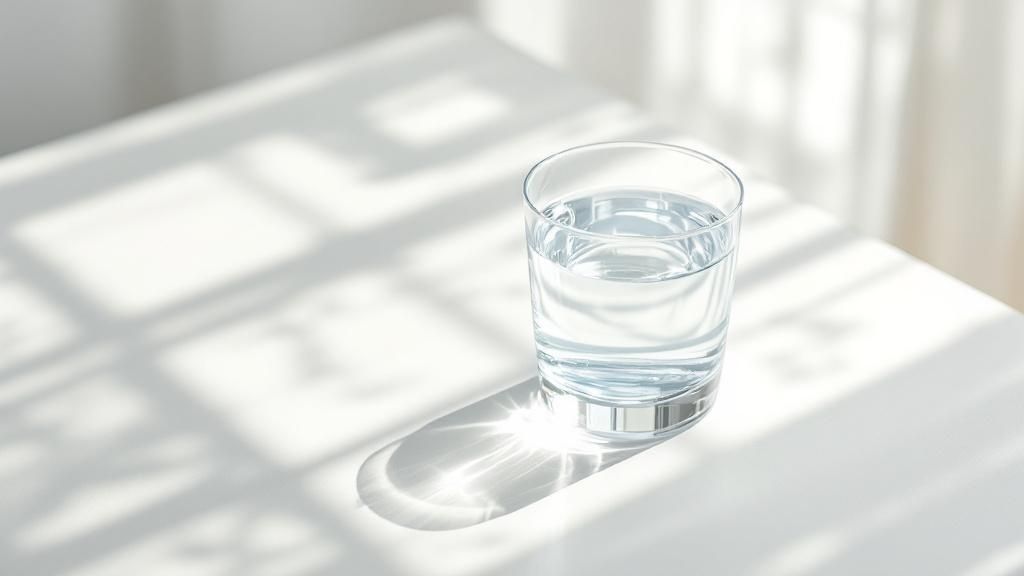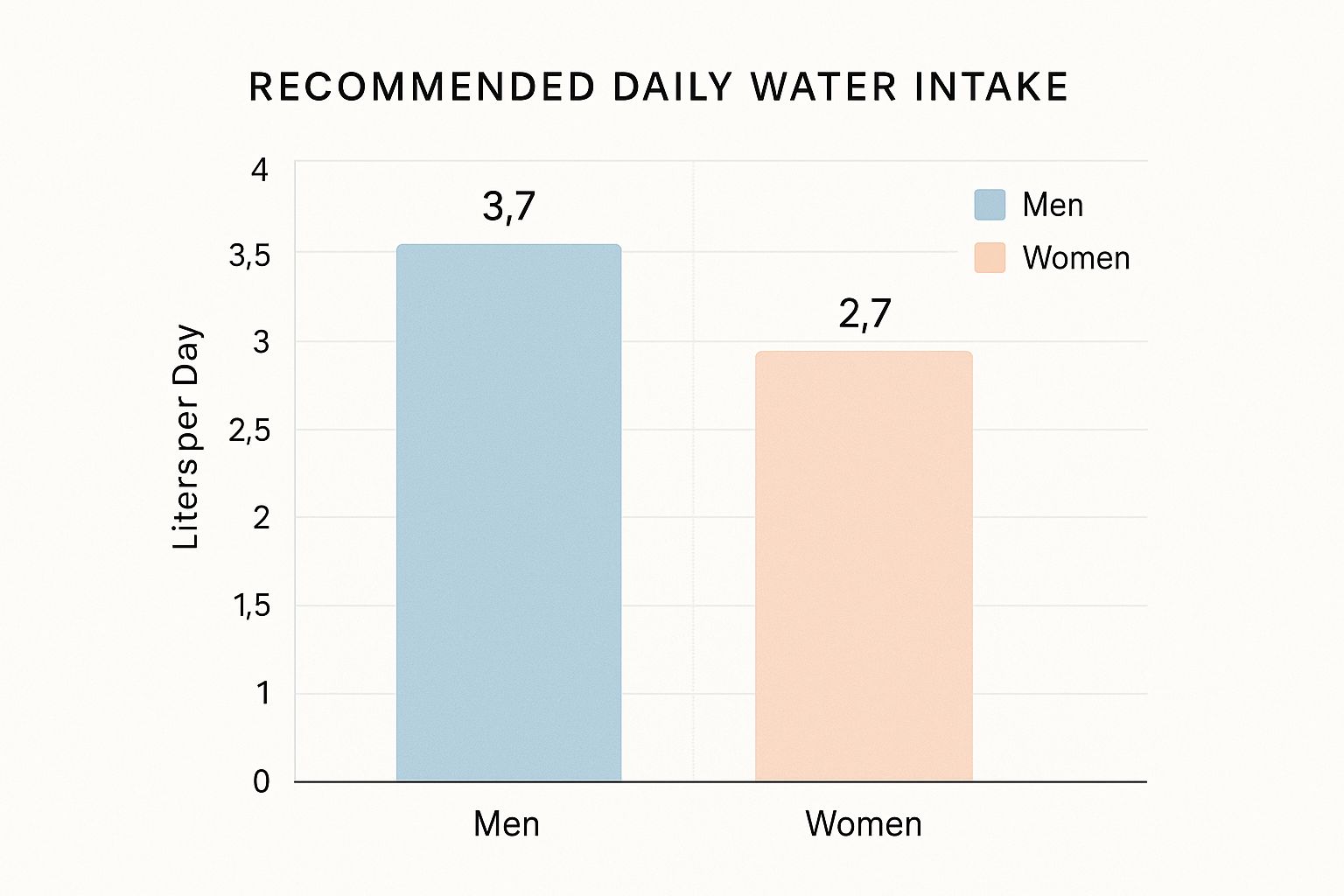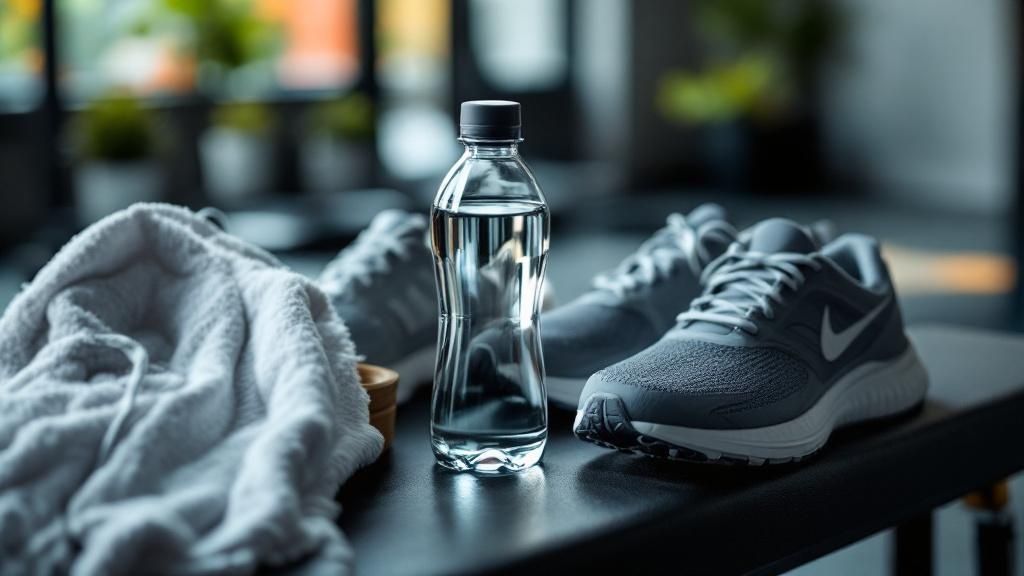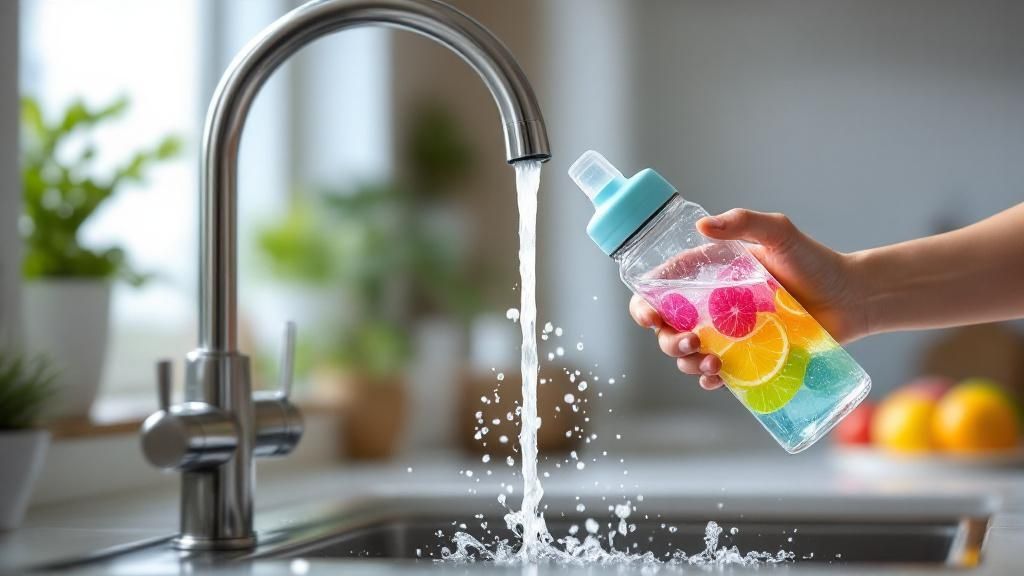Busting the 8-Glass Myth: What Science Really Says

You’ve probably heard the “8 glasses a day” rule for water intake. It’s catchy, but is it true? The reality is, this common advice isn’t as scientifically solid as it seems.
The conversation about daily water intake has been going on for ages. The eight glasses (roughly 1,900 mL) guideline is often mentioned, but it lacks strong scientific backing. Everyone’s different, and water needs change based on things like how active you are, your age, and even the weather.
For example, the European Food Safety Authority suggests 2 liters of water daily for women and 2.5 liters for men. Importantly, they’re talking about total water from all sources – food, other drinks, and plain water. Want to learn more about this? Check out this resource: Discover more insights.
It’s easy to get confused about hydration, especially with so many marketing messages out there. Think about it: you wouldn’t ask a car salesperson for medical advice, right? The same goes for hydration tips from beverage companies. Be critical of where your information comes from. This isn’t to say bottled water is bad, but it’s crucial to find advice based on real research, not just clever slogans. Want to make hydrating more fun? Try a pretty water bottle like this one: Citrine Bamboo Crystal Water Bottle.
Figuring out your hydration needs isn’t about following a single rule. It’s much more personal than that. Things like your metabolism, where you live, and how much you move around all play a big role. Interested in learning more about staying hydrated? Here are some helpful tips: Hydration hacks. So, how do you know what works best for you? We’ll explore that next.
Discovering Your Unique Hydration Blueprint

This infographic gives you a quick visual guide to daily water intake. You’ll see that men are generally advised to drink around 3.7 liters a day, while women are closer to 2.7 liters.
But think of these as ballpark figures, not hard and fast rules. Just like a chef adjusts a recipe based on the ingredients, your individual water needs will vary.
Factors Influencing Your Hydration Needs
An athlete sweating it out in the desert obviously needs more water than someone in an air-conditioned office. This highlights how activity level and climate play a huge role in your hydration needs.
Other factors also come into play:
- Body size: Larger bodies naturally require more water.
- Diet: A diet high in salty or sugary foods can increase your need for water.
- Medications: Certain medications can affect fluid balance.
Learning more about essential nutrients can provide a broader context for understanding your body’s needs. It’s not a one-size-fits-all equation. Your hydration is a dynamic balance, constantly adjusting to your lifestyle.
To illustrate the impact of these variables, let’s look at a practical comparison:
Daily Water Needs by Activity Level and Climate
| Activity Level | Temperate Climate | Hot Climate | High Altitude |
|---|---|---|---|
| Sedentary | 2.5 liters | 3.0 liters | 3.5 liters |
| Moderate Activity | 3.0 liters | 3.5 liters | 4.0 liters |
| High Activity | 3.5 liters | 4.0+ liters | 4.5+ liters |
This table provides general guidelines. In a hot climate, your body loses water through sweat more rapidly, so you’ll need to increase your intake. Similarly, at high altitudes, the dry air and increased respiration demand more hydration.
Remember, these are estimates. Listen to your body and adjust your intake as needed. If you’re feeling thirsty, chances are you’re already slightly dehydrated.
Finding Your Personal Hydration Sweet Spot
So, how do you find your perfect hydration balance? Pay attention to your body’s signals.
- Thirst: This is the most obvious sign. Don’t wait until you’re parched to drink.
- Urine color: Pale yellow urine indicates good hydration. Darker urine suggests you need more fluids.
- Energy levels: Dehydration can lead to fatigue.
By considering these factors and listening to your body, you can develop a hydration plan that truly works for you.
How Health Experts Actually Calculate Water Recommendations

Ever wondered how much water you really need to drink each day? It’s a question almost everyone asks, and the answer isn’t as simple as you might think. Imagine trying to water all the different plants in a garden – a cactus needs far less than a thirsty fern, right? Our bodies are similar; our individual water needs depend on a bunch of factors.
The Science Behind the Numbers
One of the biggest factors is our metabolic rate. Think of it like the engine of your car: a bigger engine burns more fuel and creates more exhaust. A faster metabolism burns more calories, creating more water as a byproduct. Researchers consider this when figuring out how much extra water we need.
Another surprising element? The food we eat. Around 20% of our daily water intake actually comes from the food on our plates. Fruits and vegetables, especially, contribute significantly to our hydration.
For example, the European Food Safety Authority suggests women consume around 2 liters of water daily and men around 2.5 liters. These numbers reflect average activity levels and diets. If you’re interested in more personalized hydration and exploring different water types, you might want to check out something like a hydrogen water bottle.
Adequate Intake vs. Recommended Daily Allowance
It’s also important to understand the difference between Adequate Intake (AI) and Recommended Daily Allowance (RDA). Think of it like baking a cake: an RDA is like a tried-and-true recipe with exact measurements, while an AI is like a skilled baker’s best estimate when a precise recipe isn’t available.
An RDA is based on solid scientific data, while an AI fills the gap when there’s not enough research to establish a firm RDA. This is why water recommendations can differ between countries – the level of scientific certainty behind the numbers varies. Scientists are always learning more about hydration, constantly refining their understanding and updating guidelines as new information comes to light.
For more insights into healthy habits, you might find this article on how protein helps with weight loss helpful. Ultimately, your perfect water intake is a personal equation, balancing these research methods with your own unique lifestyle.
The Gap Between What We Should Drink and What We Do
Ever sign up for a gym membership with the best intentions, only to find your workout shoes gathering dust in the closet? Hydration can be a bit like that. We know drinking enough water is important, but actually doing it consistently? That’s a different story. Many of us fall short of our daily hydration goals, and it’s not always because we’re forgetful or simply don’t care. There are real-world reasons for this hydration gap.
Let’s look at the numbers. The average adult in the United States drinks about 44 ounces (about 1.3 liters) of plain water each day. Now, compare that to the recommended intake: around 4 liters of total water for men and 3 liters for women. Keep in mind that about 80% of that total comes from beverages and the other 20% comes from food we eat. Find more details on water intake. That’s a pretty big difference, right?
So, why the discrepancy? Well, life gets in the way. Think about your own day – how easy is it to get swept up in work, errands, and everything else, only to realize you haven’t had a sip of water in hours? Our busy schedules often push hydration to the back burner.
Taste preference plays a role, too. Let’s be honest, plain water can be a bit…boring. Many people reach for flavored drinks, which often come with added sugars or artificial sweeteners. Cultural habits also influence how much water we drink. In some cultures, regularly consuming large amounts of water simply isn’t the norm. And finally, sometimes we just don’t know where to start when it comes to boosting our water intake. Recognizing these challenges is the first step towards finding realistic solutions that work for our lives.
When Water Access Shapes Health Reality

Access to clean water dramatically shapes our ability to stay hydrated. While many of us ponder how best to hydrate – sparkling water, fruit infusions, or plain tap – millions around the world face a far more fundamental challenge: simply finding safe water to drink. This stark difference highlights how fortunate some of us are to even have hydration choices.
Globally, access to clean drinking water remains a pressing issue. Think about this: as of 2022, approximately 2.2 billion people lacked access to safely managed drinking water services. This has a direct impact on how much water people can actually consume daily. The World Health Organization (WHO) states that 73% of the global population had access to safely managed drinking water in 2022. That leaves a significant portion of the world without this basic necessity. Learn more about global water access.
Water Quality vs. Water Quantity
The challenge isn’t just about having enough water; it’s about the quality of that water. Contaminated water sources can cause serious health problems, turning adequate hydration into a matter of survival. Imagine feeling thirsty but knowing the water available might make you sick. This emphasizes how closely water quality is linked to discussions about daily water intake.
In areas with limited access to clean water, even meeting the minimum hydration needs can be a daily struggle. This reality significantly affects overall health and influences the direction of health research. For further reading on related health topics, you might find this interesting: Foods that naturally boost your immune system.
The Privilege of Choice
Understanding these global water challenges puts our own hydration concerns into perspective. While fine-tuning our water intake is important for optimal health, having access to safe water in the first place is a fundamental human right. This broader view informs our understanding of hydration recommendations and encourages us to consider a more global approach to health.
Reading Your Body’s Hydration Language
Your body is constantly talking to you about its hydration levels. It’s like a subtle language you’ve always heard but haven’t quite learned to understand fluently. While thirst is the most obvious signal (and sometimes not even that reliable!), there are other clues your body drops about how much water to drink daily.
Beyond Thirst: Subtle Hydration Signals
Let’s explore some of these often-missed hydration cues, from how your skin feels to the color of your urine. For example, pale yellow urine is like a green light – it signals you’re well-hydrated. On the other hand, darker yellow or amber urine is a yellow flag, telling you to reach for your water bottle. Even seemingly unrelated issues like unexplained fatigue or headaches can sometimes be traced back to mild dehydration. You might be interested in: 10 Natural Remedies for Boosting Energy Without Caffeine.
Another indicator is your skin’s elasticity. Think of it like a quick pinch test: well-hydrated skin springs back quickly, while dehydrated skin takes a bit longer to return to normal. Your cognitive function can also be impacted. If you’re having trouble focusing or concentrating, dehydration might be playing a role.
Let’s take a closer look at some common indicators in this table:
Hydration Status Indicators
Physical and cognitive signs that indicate different levels of hydration status
| Indicator | Well Hydrated | Mild Dehydration | Moderate Dehydration |
|---|---|---|---|
| Urine Color | Pale Yellow | Darker Yellow | Amber |
| Skin Elasticity | Springs back quickly | Returns slowly | Very slow return/Tenting |
| Cognitive Function | Clear, focused | Difficulty concentrating | Foggy, disoriented |
| Thirst | Not present | Present | Intense |
| Fatigue | Minimal | Noticeable fatigue | Significant exhaustion |
This table gives a good overview of the various ways your body signals its hydration status, highlighting the differences between being well-hydrated and experiencing varying degrees of dehydration.
Why Thirst Isn’t Always Reliable
As we get older, our internal thirst mechanism can become less sensitive – kind of like a smoke detector with a weakening battery. This means by the time you actually feel thirsty, you might already be significantly dehydrated. This is why proactively hydrating, especially as we age, becomes so crucial. Don’t wait for the alarm bells; make regular water intake a daily habit.
Practical Techniques for Monitoring Hydration
Building a simple system for regularly checking your hydration status can make a world of difference. This doesn’t need to be complicated. It could be as easy as mentally noting your urine color every time you go to the bathroom. Or, if you prefer a more structured approach, set reminders on your phone to drink water throughout the day. By tuning in to these cues and being proactive, you become your own hydration detective, ensuring your body gets the fluids it needs to thrive.
Making Hydration Work in Your Real Life
Staying hydrated is crucial for a multitude of reasons. Think of it like oiling the engine of your body – proper hydration helps you power through workouts, maintain high energy levels, and even contribute to a healthier complexion. But how do you turn the knowledge of daily water intake into a habit you can actually stick to? Let’s explore how to bridge the gap between theory and your busy, real-world schedule.
Practical Strategies For Consistent Hydration
Knowing you should drink more water is one thing; actually doing it is another. Here are some tried-and-true strategies adopted by people who have successfully transformed their hydration habits:
- Timed Intake: Imagine spreading small, manageable tasks throughout your day rather than tackling one giant project all at once. This is the same principle behind timed water intake. Set reminders on your phone or use a marked water bottle to track your progress.
- Hydrating Foods: It’s easy to overlook the fact that approximately 20% of our daily water intake comes from the food we eat. Fruits and vegetables like watermelon, cucumbers, and spinach can significantly contribute to your hydration goals. Think of them as a delicious bonus!
- Make Water Appealing: If the thought of plain water makes you yawn, get creative! Infuse your water with slices of fruits like oranges or lemons, sprigs of herbs like mint or basil, or even a small splash of unsweetened juice.
Tools and Tech: Helpful or Hype?
From fancy apps to high-tech water bottles, there’s a whole market dedicated to reminding you to drink water. While some tools can be useful, others become expensive distractions. The key is finding a system that works for you, and sometimes the simplest approach is the best. Maybe it’s setting a timer on your phone or keeping a reusable water bottle within arm’s reach.
Realistic Goal Setting: The Psychology of Success
Don’t try to become a hydration superhero overnight. Just like building any habit, consistency trumps intensity. Start small, acknowledge your progress, and don’t beat yourself up if you miss a day. Begin by gradually increasing your water intake. If you typically drink very little, aim to add an extra glass or two each day. Once that becomes a natural part of your routine, add another. This gradual approach is far more sustainable than drastic, short-lived changes.
Visit Health Lifestyle News for more practical wellness advice, tailored to help you live a healthier and more balanced life. We offer evidence-based insights on nutrition, fitness, mental health, weight management, and natural remedies – everything you need to support your journey towards optimal wellbeing.




